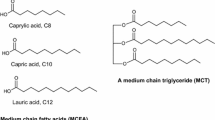Abstract
In the present study, seed oil content and fatty acid composition of 15 commercially important pomegranate cultivars were determined. The oil content of pomegranate seeds ranged between 13.95 and 24.13% (d.b). Palmitic, stearic, arachidic, and behenic acid contents of the oils ranged between 2.10–2.77, 1.35–2.01, 0.33–0.48, and 0.16–0.22%, respectively. The predominant unsaturated fatty acid was punicic acid (70.42–76.17%) and a minor unsaturated fatty acid was gadoleic acid (0.42–0.75%). The analysis on unsaturated fatty acids particularly showed significant amounts of punicic acid, which is considered to enhance the oil quality and is of importance to health.

Similar content being viewed by others
References
Schubert SY, Lansky EP, Neman I (1999) Antioxidant and eicosanoid enzyme inhibition properties of pomegranate seed oil and fermented juice flavonoids. J Ethnopharmacol 66:11–17
Alighourchi H, Barzegar M, Abbasi S (2008) Anthocyanins characterization of 15 Iranian pomegranate (Punica granatum L.) varieties and their variation after cold storage and pasteurization. Eur Food Res Technol 227:881–887
Anonymous (2004) Tarımsal Yapı (Üretim, Fiyat, Değer). Devlet İstatistik Enstitüsü
Artes F, Tomas-Barberan FA (2000) Post-harvest technological treatments of pomegranate and preparation of derived products. Symposium on production, processing and marketing of pomegranate in The Mediterranean Region: advances in research and technology. CIHEAM-IAMZ Zaragoza, Spain 15–17 October 1998, pp 199–204
Vardin H, Abbasoğlu M (2004) Nar Ekşisi ve Narın Diğer Değerlendirilme Olanakları. Geleneksel Gıdalar Sempozyumu. 165–169 Van
Fadavi A, Barzegar M, Azizi MH (2006) Determination of fatty acids and total lipid content in oilseed of 25 pomegranates varieties grown in Iran. J Food Compost Anal 19:676–680
Hernandez F, Melgarejo P, Olias JM, Artes F (2000) Fatty acid composition and total lipid content of seed oil from three commercial pomegranate cultivars. Symposium on production, processing and marketing of pomegranate in The Mediterranean Region: advances in research and technology. CIHEAM-IAMZ Zaragoza, Spain 15–17 October 1998, pp 205–209
Yücel SÖ (2005) Determination of conjugated linolenic acid content of selected oil seeds grown in Turkey. J Am Oil Chem Soc 82:893–897
Yasui Y, Hosokawa M, Sahara T, Suzuki R, Ohgiya S, Kohno H, Tanaka T, Miyashit K (2005) Bitter gourd seed fatty acid rich in 9c, 11t, 13t-conjugated linolenic acid induces apoptosis and up-regulates the GADD45, p53 and PPARg in human colon cancer Caco-2 cells. Prostaglandins Leukot Essent Fatty Acids 73:113–119
Igarashi M, Miyazawa T (2000) Newly recognized cytotoxic effect of conjugated trienoic fatty acids on cultured human tumor cells. Cancer Lett 148:173–179
Gerber M, Thiébaut A, Astorg P, Clavel-Chapelon F, Combe N (2005) Dietary fat, fatty acid composition and risk of cancer. Eur J Lipid Sci Technol 107:540–559
Dubois V, Breton S, Linder M, Fanni J, Parmentier M (2007) Fatty acid profiles of 80 vegetable oils with regard to their nutritional potential. Eur J Lipid Sci Technol 109:710–732
Cao Y, Gao HL, Chen J-N, Chen Z-Y, Yang L (2006) Identification and characterization of conjugated linolenic acid isomers by Ag+ -HPLC and NMR. J Agric Food Chem 54:9004–9009
Yasmin A, Takeuchi T, Hirota T, Ishida S (2004) Effect of conjugated linolenic acid (cis-9, trans-11, cis-13–18:3) on growth performance and lipid composition of fingerling rainbow trout Oncorhynchus mykiss. Fish Sci 70:1009–1018
Gölükcü M, Tokgöz H (2008) Ülkemizde yetiştirilen önemli nar (Punica granatum L.) çeşitlerine ait nar sularının bazı kalite özellikleri. Hasad-Gıda 274:26–31
Anonymous (1990) Fatty acids in oils and fats. Helrich K (ed) AOCS official methods of analysis, vol 2, 15th edn, pp 963–964
Melgarejo P, Artes F (2000) Total lipid content and fatty acid composition of oilseed from lesser known sweet pomegranate clones. J Sci Food Agric 80:1452–1454
Harris HC, McWilliam JR, Mason WK (1978) Influence of temperature on oil content and composition of sunflower seed. Aust J Agric Res 29:1203–1212
Flagella Z, Rotunno T, Tarantino E, Di Caterina R, De Caro A (2002) Changes in seed yield and oil fatty acid composition of high oleic sunflower (Helianthus annuus L.) hybrids in relation to the sowing date and the water regime. Eur J Agronomy 17:221–230
Seiler GJ (1983) Effect of genotype, flowering date, and environment on oil content and oil quality of wild sunflower seed. Crop Sci 23:1063–1068
Dolde D, Vlahakis C, Hazebroek J (1999) Tocopherols in breeding lines and effects of planting location, fatty acid composition, and temperature during development. JAOCS 76:349–355
Yaniv Z, Ranen C, Levy A, Palevitch D (1989) Effect of temperature on the fatty acid composition and yield of evening primrose (Oenothera lamarckiana) seeds. J Ex Bot 40:609–613
Holaday CH, Pearson JL (1974) Effects of genotype and production area on the fatty acid composition, total oil and total protein in peanuts. J Food Sci 39:1206–1209
Lajara JR, Diaz U, Quldlello RD (1990) Definite influence of location and climatic conditions on the fatty acid composition of sunflower seed oil. J Am Oil Chem Soc 67:618–623
Thompson DL, Jellum MD, Young CT (1973) Effect of controlled temperature environments on oil content and on fatty acid composition of corn oil. J Am Oil Chem Soc 50:540–542
Robertson JA, Chapman GW, Wilson RL (1978) Relation of days after flowering to chemical composition and physiological maturity of sunflower seed. J Am Oil Chem Soc 55:266–269
Acknowledgment
We are grateful to the Scientific and Technical Research Council of Turkey (TUBITAK), Project No 106 O 265, for financial support.
Author information
Authors and Affiliations
Corresponding author
Additional information
An erratum to this article can be found at http://dx.doi.org/10.1007/s11746-009-1450-z
About this article
Cite this article
Kýralan, M., Gölükcü, M. & Tokgöz, H. Oil and Conjugated Linolenic Acid Contents of Seeds from Important Pomegranate Cultivars (Punica granatum L.) Grown in Turkey. J Am Oil Chem Soc 86, 985–990 (2009). https://doi.org/10.1007/s11746-009-1436-x
Received:
Revised:
Accepted:
Published:
Issue Date:
DOI: https://doi.org/10.1007/s11746-009-1436-x




